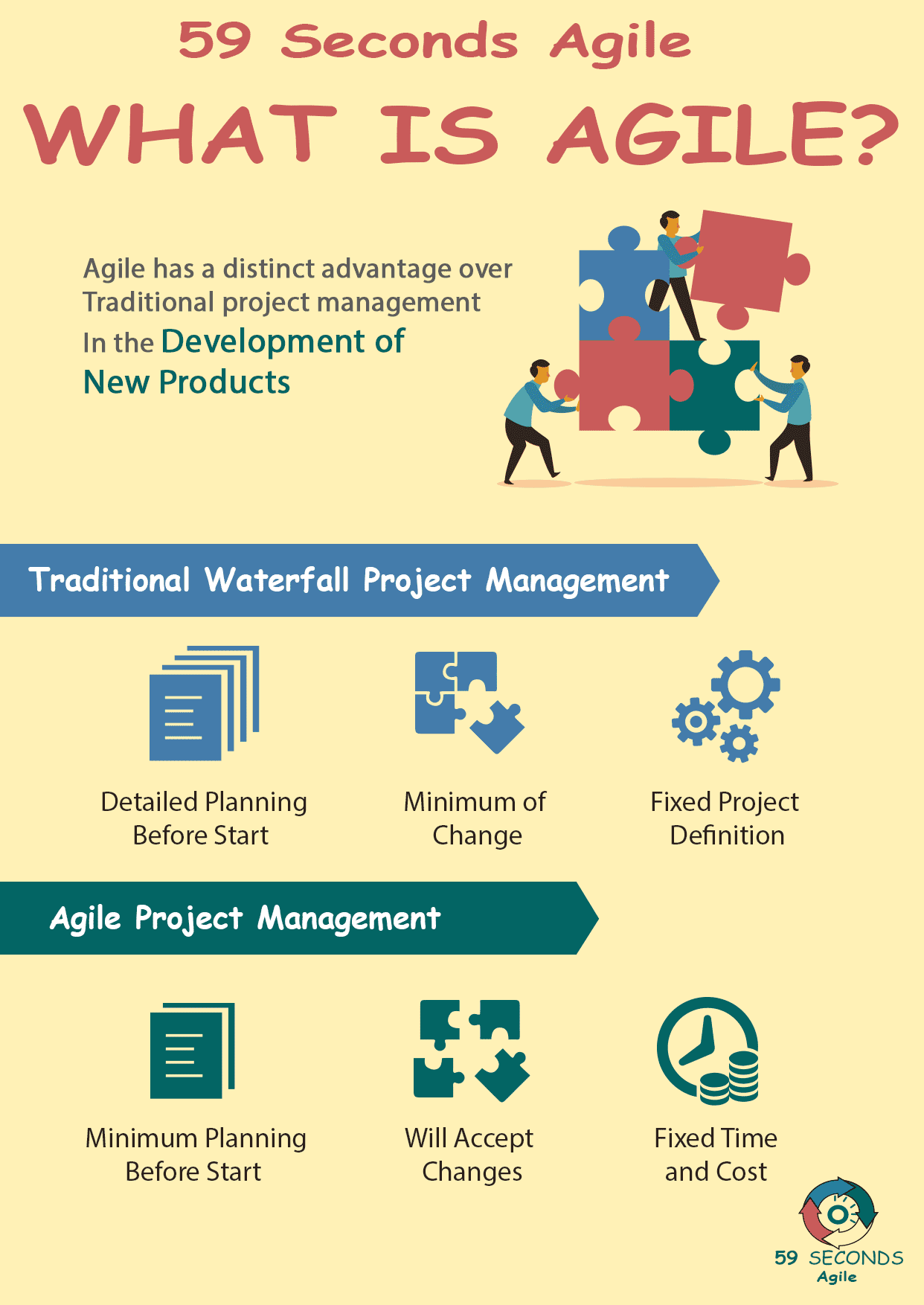What is Agile Development and what role do the developers play within an Agile development project? This article takes a look into what is Agile Development.
What is Agile Development?
A 59 Seconds Agile Video Animation
What is Agile Development for Developers
A 59 Seconds Agile Article
Agile software development is a popular method of project management. It has become the standard for many organizations for several reasons. Most importantly, Agile is an improvement over traditional project management styles like Waterfall thanks to its iterative nature. Software organizations attempt to maximize efficiency and minimize waste, and Agile allows them to do this.
How specifically does Agile improve on Waterfall methods? One of the biggest improvements is the cyclical nature of Agile. Where Waterfall development does the entire process in one direction, Agile iterates through the process several times. This allows the Scrum team to inspect and adapt. Basically, at the end of each cycle or sprint, they look at what went well and what didn’t. The Scrum team then plans for changes to the next sprint, in order to adapt. Ultimately, this results in a team that becomes more efficient as time goes on.
What is Agile Development: Lightweight Development
Agile gets its name from being a lightweight style of development. Documentation is kept to a minimum. Work on any particular feature begins at the last minute. It isn’t bogged down with all of the official steps in traditional development methods. Since technology as an industry evolves so quickly, it makes sense that software development methods would as well.
What is Agile Development: Agile for Developers
What does Agile mean for developers? How do the differences between Agile and more traditional methods affect the duties of the developer role? Agile improves the process for developers. They can work more confidently, and waste less time on features that get scrapped later.
What is Agile Development: Less Wasted Work
A key part of Agile is that any work on a feature waits until the last minute. In Waterfall development, every feature must go through every step at the start of the project. All of the documentation for every feature is completely written out before any work is started. Developers stick to this plan, and write the code for all features. Since this process takes time, many projects may slow down in development. If features are removed from scope after the start of the project then already written code for the cancelled features, is wasted time.
Work in Agile waits until it is necessary. A feature only begins development once it is committed to a sprint. This way, the Scrum team can focus on a few specific tasks and features. They only write the documentation as it is necessary. Developers only write the code once a feature will definitely be included in the next release. Since work is contained in a single iteration, every few weeks of work gets shipped off to customers as a finished part of the product. If a feature does somehow get cancelled in a sprint, the inspect and adapt process minimizes the chances of that happening again. The Scrum team can look at what went wrong to cause the feature to be cancelled, and adapt to make sure that future Sprints do not encounter those problems.
What is Agile Development: Better Defined Requirements
Documentation is sparse in Agile projects, but often better than the documentation of Waterfall development. Traditional software development takes the stance that more documentation is better. Every feature is fleshed out as much as it can be. Every single bit of information is included. Unfortunately, much of this comes from the team itself. They create what they think the customer wants. This often results in features that aren’t necessarily what the customer needed. However, since things are done in a step by step fashion, going back to change things is cumbersome. The red tape that developers must go through to get a change into a project after it is created often results in a huge delay before problems are fixed.
Prev <— Continue Reading —> Next
Learn More: An Introduction to Agile
User Stories Applied
A 59 Seconds Agile Book Review
User Stories Applied by Mike Cohn is one of our favourite books on Agile User Stories. The book starts with an overview into user stories, and details what a user story is and the different aspects of them. He then discusses how to go about writing a user story, and provides details of the INVEST criteria that can be used to determine if the story is meeting all of its objectives. Next Mike gives an in depth discussion of who user stories are written for and where to begin when gathering the details for them. The book then discusses acceptance testing user stories, including how to go about specifying these criteria and the responsibilities of the development team and customers during this process.
Prev <— Continue Reading —> Next
Learn More: An Introduction to Agile
What is Agile Development?
A 59 Seconds Agile Infographic

Prev <— Continue Reading —> Next
Learn More: An Introduction to Agile
Prev <— Continue Reading —> Next
Learn More: An Introduction to Agile
Our Favourite Agile Books
We found these books great for finding out more information on Agile Scrum:

